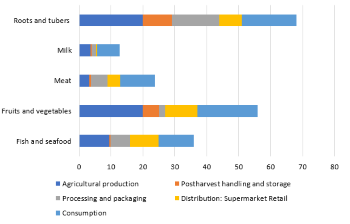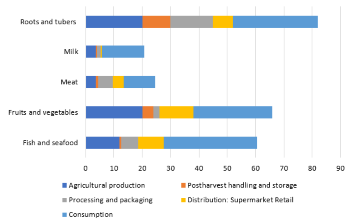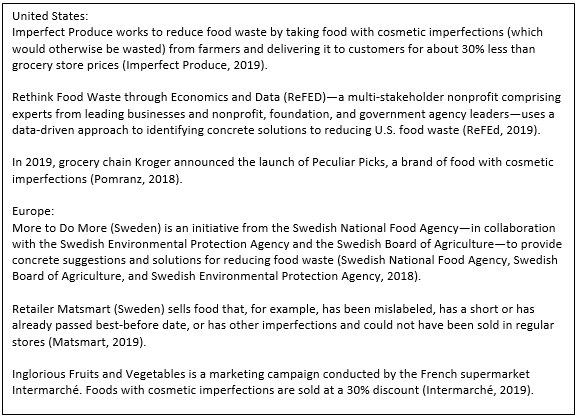
Food waste—to a large extent a result of people’s consumption and purchase habits—is increasingly recognized as a challenge facing both developed and developing economies (Aschemann-Witzel et al., 2017b; Ellison and Lusk, 2018). Therefore, investigating opportunities to shift retail practices and influence consumers at point of purchase is important if food waste is to be reduced, which could have an impact on food security, nutrition, household budgets, the environment, and public health (Hall et al., 2009; Neff, Spiker, and Truant, 2015; Spiker et al., 2017).
Importantly, consumers’ propensity to not accept food that visually deviates from the norm because of cosmetic imperfections—such as being misshapen, off-color, or slightly damaged—contributes to consumer food waste (Aschemann-Witzel et al., 2015, 2017a,b; de Hooge et al., 2017). Products and produce not meeting ideal visual standards are disposed as waste downstream in the value chain and discarded at the point of purchase or at home.

Source: Gustavsson, Cederberg, and Sonesson (2011, p. 26).

Source: Gustavsson, Cederberg, and Sonesson (2011, p. 26).
According to the U.S. Department of Agriculture, a substantial amount of food waste occurs in retail and consumer settings (Buzby, Farah-Wells, and Hyman, 2014). In 2010, around 31% of food was wasted at the retail and consumer level in the United States, corresponding to approximately 133 billion pounds and $161 billion worth of food (Buzby, Farah-Wells, and Hyman, 2014). Figures 1 and 2 summarize food waste across Europe, North America, and Oceania; with roots and tubers as well as fruits and vegetables (Gustavsson, Cederberg, and Sonesson, 2011). Some food waste is inevitable, but food waste at the current scale indicates inefficient resource use. For example, about 24% of total water and cropland use are, in fact, used to produce waste (Kummu et al., 2012). Importantly, food waste contributes to the environmental burden of food production owing to resources spent in vain (Kummu et al., 2012; Aschemann-Witzel, 2016).
While recent studies show that U.S. consumers perceive themselves to be knowledgeable and engaged with the issue of food waste (Ellison and Lusk, 2018; Neff, Spiker, and Truant, 2015), many consumers do not purchase imperfect or blemished food in retail stores due to food safety misconceptions (Aschemann-Witzel, 2016). Since supermarkets remain the main purchase point for food, they have the ability to influence which products make it on the shelves and the types of food consumers purchase (Escaron et al., 2013). Supermarkets also have the power to decide what happens to unsold food and how to encourage consumers to buy visually imperfect food to reduce food waste. Box 1 lists examples of recent retailer, nonprofit organization, and government agency initiatives to reduce food waste in Europe and the United States.
A number of studies have focused on food waste, but we argue that there remains a need for studies that examine the effectiveness of different strategies or initiatives that retailers can implement to increase consumers’ acceptance of food with cosmetic imperfections. Retail initiatives (see Box 1) can only work as long as they relate to consumers’ needs and wants and therefore instill sustained behavioral changes in favor of greater degrees of acceptance of visually imperfect food. Hence, an assessment of the effect of specific initiatives on consumer information processing, acceptance, and motivation is important.


Before touching or tasting, consumers generally first analyze food visually (Lee et al., 2013), resulting in a first impression about the product’s quality. According to the literature, consumers assess three characteristics of the visual appearance of fruit and vegetable relevant: (i) color, (ii) shape, and (iii) physical form (Blasco et al., 2007; Loebnitz, Schuitema, and Grunert, 2015; Salvador, Sanz, and Fiszman, 2007; Seppä et al., 2013). These attributes affect customers’ purchase intentions, but only if they deviate significantly from the norm (Loebnitz, Schuitema, and Grunert, 2015). Since fresh fruit and vegetables are often not packaged, or are packaged in a way that allows the produce to be seen (Deng and Srinivasan, 2013), they offer an appropriate product to study consumers’ preferences for food with cosmetic imperfections (see Table 1).
Examining visual appearance (with or without imperfections) fits with the established multi-attribute utility perspective, which implies that consumers derive their utility (or happiness) not from the item itself (e.g., the tomato) but from the attributes contained in that particular item, such as color, flavor, etc. (Lancaster, 1966). However, even though the multi-attribute perspective has come to play a significant role in understanding the decision-making process, there is a need for a more multifaceted understanding; hence, recent research has moved away from the Lancaster utility model (Marley and Swait, 2017; van Osselaer and Janiszewski, 2012). Studies that examine the effect of information related to food waste and goal setting could help bring about a better understanding of how consumers can be nudged to accept food with cosmetic imperfections.
Many factors can influence decision making, and nudging is one of them. A nudge is a change in the way in which choices are presented, altering behavior in a predictable way without forbidding any options or significantly changing economic incentives. According to a recent meta-analysis by Cadario and Chandon (2017), nudging interventions can be divided into three categories:
The effectiveness of the intervention increases significantly as the focus shifts from attention to interest to action (Cadario and Chandon, 2017).
While many studies focus on the impact of nudges on consumers’ perceptions about and willingness to buy certain types of food (Cadario and Chandon, 2017; McFadden and Huffman, 2017; Nayga, Aiew, and Nichols, 2005; Valente and Chaves, 2018) and whether information can guide consumers to make better-informed choices or change behavior (Qi and Roe, 2017), there is scant literature on the impact of nudges in relation to food waste in retail settings.
Based on previous studies, we suggest that cognitive nudges could be used at the point of purchase. For this purpose, we need more research to determine whether providing information about the amount and consequences of food waste would change purchase behavior and increase acceptance of food with cosmetic imperfections. Whether framing the information in a positive or negative way might influence consumer behavior could also be evaluated. While information nudges have shown good results, it is behavioral nudges (such as convenience enhancements) that have been shown to have the greatest effects (Cadario and Chandon, 2017). Therefore, studies are needed on ways to assist retailers with developing business and marketing actions that can reduce food waste at their stores.
In addition to nudges, goals can also play an important role in decision making as we illustrate with this example inspired by Dellaert et al. (2018): Assume a person is buying a takeaway meal. Two personal goals play an important role in making this decision: (i) to avoid gaining weight and (ii) to eat something tasty. The person may set some minimum requirements for each goal to be fulfilled and choose a meal that satisfies these requirements (e.g., tasty and low in calories). Or, the person may decide to focus on fulfilling only one of the goals (e.g., choose a tasty meal that may be high in calories). At this stage in the decision-making process, the person only decides (reasoned or unreasoned) which goal to pursue without assigning any utility value to either of the two meal alternatives; hence, the person chooses a strategy without considering the two options. However, according to the established multi-attribute utility perspective, both meals have a utility value based on their attributes. Then, the person makes a decision based on which meal has the highest utility value without considering the trade-off between the two goals. Not considering the trade-offs between the two goals offers an incomplete picture about how consumers make decisions and what it might take to actually make them change those decisions (Dellaert et al., 2018).
According to goal-based theory, goals are seen as (i) drivers of choice, (ii) able to explain the choice of strategy, (iii) included in the constraint set, and (iv) able to help explain the effect of the decision context in the allocation of the decision maker’s cognitive resources (van Osselaer and Janiszewski, 2012; Marley and Swait, 2017). Therefore, goals serve as reference points for consumers and direct the selection of means to their attainment—meaning that forming personal goals related to food waste will direct the means used by consumers to reduce waste (Lagerkvist et al., 2015). Research to develop and test behavioral nudges that target such goal-setting as well as the selection of “means to an end” is therefore needed. There are also reasons to expect that goal-setting relates to the affective and emotional post-purchase experiences. Hence, whether consumers are satisfied with their choice of a particular food product has to do with whether one or more goals can be attained (Lagerkvist et al., 2017). Future research on food waste behaviors using a goal-based approach can therefore contribute to a better understanding of consumer food waste behavior. Decision making can be difficult due to time or money limitations or due to too many food products being available. Personal goals can therefore help direct consumers to make choices in the presence of scarce resources, such as money or time (Dellaert et al., 2018).
In summary, we posit that a combination of cognitive and behavioral nudges should be tested in food-waste reduction campaigns that aim to encourage consumers to become more aware of the extent and consequences of food waste and how some behavioral changes, such as accepting food with cosmetic imperfections, can contribute to reducing food waste. This information will help retailers tailor actions to support consumers to consider or buy fruits and vegetables with cosmetic imperfections, thereby reducing food waste. Advertising imperfect or blemished fresh fruits and vegetables as safe and as something that should not be discarded could also work as goal priming that could potentially shift consumer motivation (Aschemann-Witzel, 2016). The hope is that by finding ways to encourage consumers to purchase fresh fruits and vegetables with cosmetic imperfections, food waste at the retail level can be significantly reduced.
Aschemann-Witzel, J. 2016. “Waste Not, Want Not, Emit Less.” Science 352(6284): 408–409. doi:10.1126/science.aaf2978
Aschemann-Witzel, J., I. de Hooge, P. Amani, T. Bech-Larsen, and M. Oostindjer. 2015. “Consumer-Related Food Waste: Causes and Potential for Action.” Sustainability 7(6): 6457–6477. doi:10.3390/su7066457
Aschemann-Witzel, J., I.E. de Hooge, H. Rohm, A. Normann, M.B. Bossle, A. Grønhøj, and M. Oostindjer. 2017a. “Key Characteristics and Success Factors of Supply Chain Initiatives Tackling Consumer-Related Food Waste – A Multiple Case Study.” Journal of Cleaner Production 155: 33–45. doi:10.1016/j.jclepro.2016.11.173
Aschemann-Witzel, J., J.H. Jensen, M.H. Jensen, and V. Kulikovskaja. 2017b. “Consumer Behaviour Towards Price-Reduced Suboptimal Foods in the Supermarket and the Relation to Food Waste in Households.” Appetite 116: 246–258. doi:10.1016/j.appet.2017.05.013
Blasco, J., N. Aleixos, J. Gómez, and E. Moltó. 2007. “Citrus Sorting by Identification of the Most Common Defects Using Multispectral Computer Vision.” Journal of Food Engineering 83(3): 384–393. doi:10.1016/j.jfoodeng.2007.03.027
Buzby, J.C., H. Farah-Wells, and J. Hyman. 2014. The Estimated Amount, Value, and Calories of Postharvest Food Losses at the Retail and Consumer Levels in the United States Washington, DC: U.S. Department of Agriculture, Economic Research Service, Economic Information Bulletin EIB-164262.
Cadario, R., and P. Chandon. 2017. “Which Healthy Eating Nudges Work Best? A Meta-Analysis of Field Experiments.” SSRN Electronic Journal. doi:10.2139/ssrn.3090829
de Hooge, I.E., M. Oostindjer, J. Aschemann-Witzel, A. Normann, S.M. Loose, and V.L. Almli. 2017. “This Apple Is Too Ugly for Me!” Food Quality and Preference 56: 80–92. doi:10.1016/j.foodqual.2016.09.012
Dellaert, B.G.C., J. Swait, W.L.V. Adamowicz, T.A. Arentze, E.E. Bruch, E. Cherchi, C. Chorus, B. Donkers, F.M. Feinberg, A.A.J. Marley, and L.C. Salisbury. 2018. “Individuals’ Decisions in the Presence of Multiple Goals.” Customer Needs and Solutions 5(1–2): 51–64. doi:10.1007/s40547-017-0071-1
Deng, X., and R. Srinivasan. 2013. “When Do Transparent Packages Increase (or Decrease) Food Consumption?” Journal of Marketing 77(4): 104–117. doi:10.1509/jm.11.0610
Ellison, B., and J.L. Lusk. 2018. “Examining Household Food Waste Decisions: A Vignette Approach.” Applied Economic Perspectives and Policy 40(4): 613–631. doi:10.1093/aepp/ppx059
Escaron, A.L., A.M. Meinan, S.A. Nitzke, and A.P. Martinez-Donate. 2013. “Supermarket and Grocery Store–Based Interventions to Promote Healthful Food Choices and Eating Practices: A Systematic Review.” Preventing Chronic Disease 10: 120156. doi:10.5888/pcd10.120156
Gustavsson, J., C. Cederberg, and U. Sonesson. 2011. Global Food Losses and Food Waste: Extent, Causes and Prevention. Study conducted for the Save Food! at Interpack international congress, Düsseldorf, Germany, May 16–17. Rome: Food and Agriculture Organization of the United Nations, p. 26.
Hall, K.D., J. Guo, M. Dore, and C.C. Chow. 2009. “The Progressive Increase of Food Waste in America and Its Environmental Impact.” PLoS ONE 4(11). doi:10.1371/journal.pone.0007940
Imperfect Produce. 2019. Imperfect: Ugly Produce Delivery for About 30% Less! Available online: https://www.imperfectproduce.com/ [Accessed Jan 8, 2019]
Intermarché. 2019. Inglorious Fruits and Vegetable. Available online: http://itm.marcelww.com/inglorious/ [Accessed Jan 8, 2019]
Kummu, M., H. de Moel, M. Porkka, S. Siebert, O. Varis, and P.J. Ward. 2012. “Lost Food, Wasted Resources: Global Food Supply Chain Losses and Their Impacts on Freshwater, Cropland, and Fertiliser Use.” Science of The Total Environment 438: 477–489. doi:10.1016/j.scitotenv.2012.08.092
Lagerkvist, C.J., A. Normann, and A. Åström. 2015. ”A Theoretical Description and Experimental Exploration of Tri-Reference Point Theory with Respect to Food Choice.” Food Quality and Preference 41: 60–74. doi:10.1016/j.foodqual.2014.11.006
———. 2017. “Product Satisfaction in Food Choice Is Multiple-Reference Dependent: Evidence from an in-Store Non-Hypothetical Consumer Experiment on Bread.” Food Quality and Preference 56: 8–17. doi:10.1016/j.foodqual.2016.09.006
Lancaster, K.J. 1966. “A New Approach to Consumer Theory.” Journal of Political Economy 74(2): 132–157. doi:10.1086/259131
Lee, S.-M., K.-T. Lee, S.-H. Lee, and J.-K. Song. 2013. “Origin of Human Colour Preference for Food.” Journal of Food Engineering 119(3): 508–515. doi:10.1016/j.jfoodeng.2013.06.021
Loebnitz, N., G. Schuitema, and K.G. Grunert. 2015. “Who Buys Oddly Shaped Food and Why? Impacts of Food Shape Abnormality and Organic Labeling on Purchase Intentions.” Psychology & Marketing 32(4): 408–421. doi:10.1002/mar.20788
Marley, A.A.J., and J. Swait. 2017. “Goal-Based Models for Discrete Choice Analysis.” Transportation Research Part B: Methodological 101: 72–88. doi:10.1016/j.trb.2017.03.005
Matsmart. 2019. Startsida Matsmart. Available online: https://www.matsmart.se/ [Accessed January 8, 2019]
McFadden, J.R., and W.E. Huffman. 2017. “Willingness-to-Pay for Natural, Organic, and Conventional Foods: The Effects of Information and Meaningful Labels.: Food Policy 68: 214–232. doi:10.1016/j.foodpol.2017.02.007
Nayga, R.M., W. Aiew, and J.P. Nichols. 2005. “Information Effects on Consumers’ Willingness to Purchase Irradiated Food Products.” Review of Agricultural Economics 27(1): 37–48.
Neff, R.A., M.L. Spiker, and P.L. Truant. 2015. “Wasted Food: U.S. Consumers’ Reported Awareness, Attitudes, and Behaviors.” PLOS ONE 10(6): e0127881. doi:10.1371/journal.pone.0127881
Pomranz, M. 2018, October 16. “Kroger Launches Ugly Produce Program.” Food & Wine. Available online: https://www.foodandwine.com/news/kroger-ugly-produce-peculiar-picks
Qi, D., and B.E. Roe. 2017. “Foodservice Composting Crowds Out Consumer Food Waste Reduction Behavior in a Dining Experiment.” American Journal of Agricultural Economics 99(5): 1159–1171.
ReFEd. 2019. ReFED. Available online: http://www.refed.com [Accessed January 8, 2019]
Salvador, A., T. Sanz, and S.M. Fiszman. 2007. ”Changes in Colour and Texture and Their Relationship with Eating Quality during Storage of Two Different Dessert Bananas.” Postharvest Biology and Technology 43(3): 319–325. doi:10.1016/j.postharvbio.2006.10.007
Seppä, L., J. Railio, K. Vehkalahti, R. Tahvonen, and H. Tuorila. 2013. “Hedonic Responses and Individual Definitions of an Ideal Apple as Predictors of Choice: The Role of Liking, Not Liking and Flexibility.” Journal of Sensory Studies 28(5): 346–357. doi:10.1111/joss.12059
Spiker, M.L., H.A.B. Hiza, S.M. Siddiqi, and R.A. Neff. 2017. “Wasted Food, Wasted Nutrients: Nutrient Loss from Wasted Food in the United States and Comparison to Gaps in Dietary Intake.” Journal of the Academy of Nutrition and Dietetics 117(7): 1031–1040.e22. doi:10.1016/j.jand.2017.03.015
Swedish National Food Agency, Swedish Board of Agriculture, and Swedish Environmental Protection Agency. 2018. Fler Gör Mer! Handlingsplan för Minskat Matsvinn 2030. Available online: https://www.livsmedelsverket.se/globalassets/matvanor-halsa-miljo/miljo/matsvinn/fler-gor-mer-handlingsplan-for-minskat-matsvinn_20180618.pdf
Valente, M., and C. Chaves. 2018. “Perceptions and Valuation of GM Food: A Study on the Impact and Importance of Information Provision.” Journal of Cleaner Production 172: 4110–4118. doi:10.1016/j.jclepro.2017.02.042
van Osselaer, S.M.J., and C. Janiszewski. 2012. “A Goal-Based Model of Product Evaluation and Choice.” Journal of Consumer Research 39(2): 260–290. doi:10.1086/662643